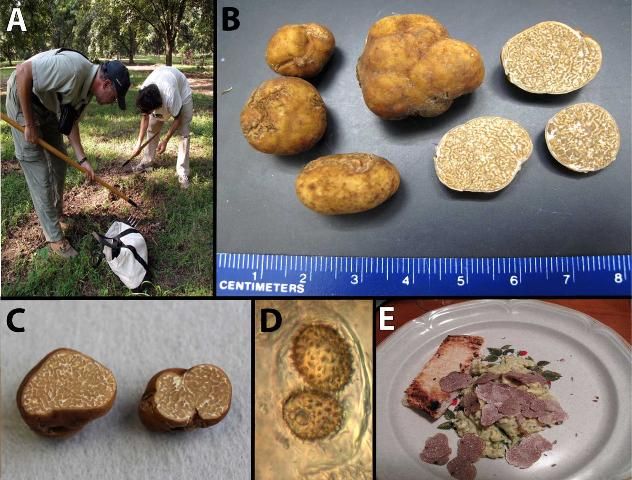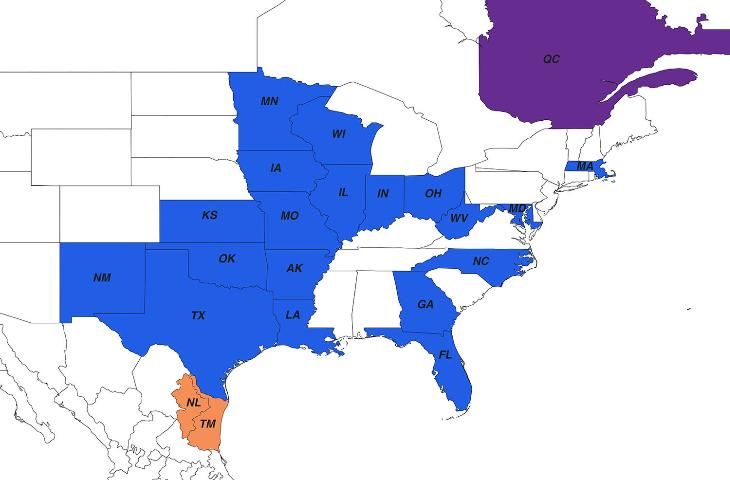Summary
A truffle is a round, knobby, or lobed mushroom fruiting body that forms below ground. The "pecan truffle" (Tuber lyonii) is an edible truffle species, native to eastern North America (east of the Rocky Mountains). This fungus lives in a mutually beneficial relationship with the roots of some trees, including species of oak (Quercus), hazelnut (Corylus spp.), and hickory (Carya spp.) trees, as well as the cultivated pecan tree (Carya illinoinensis). These truffles can be found in the wild, but because they are common in commercial pecan orchards they are often referred to as "pecan truffles." Pecan truffles are distributed throughout the southern and eastern United States from New Mexico to Florida and have been found as far north as Québec and as far south as northern Mexico. This truffle can range in size from an inch to several inches in diameter (approximately up to the size of a golf ball). It has a light brown outer skin (peridium) that can be rounded, have "lobes," and may be furrowed or smooth. When the mature truffles are cut in half, they have a marbled interior with white sterile veins layered between brown veins where the spores are produced. Pecan truffles have a slightly nutty flavor that pairs well with a variety of dishes and can be found locally in select restaurants when the fungus is in season. Commercially, fresh pecan truffles are sold for approximately $10–20 per ounce (typically 1–4 truffles per ounce), which makes them more affordable than some imported truffle species such as Tuber melanosporum (the European black truffle). Given the ability of pecan truffles to grow with commercial pecan trees, there is a growing interest in the potential for pecan farmers to produce this truffle within their orchards to diversify and improve their farm economy.
Introduction
Truffle fruiting bodies form belowground. They are usually white, various shades of yellow, brown, or black. They can be smooth to warty in texture on their outer surface. When truffles are mature, they produce aromatic compounds that attract animals, particularly pigs and a variety of small mammal species. These animals consume the truffles and disperse the truffle spores in their scat (Cazares and Trappe 1994; Gabel et al. 2010). Not only do truffles provide food for animals, but most of these belowground fungi also form a mutually beneficial association with the roots of trees. This is a symbiotic association called ectomycorrhizae. In this relationship the fungi form a network with their hyphae (the vegetative body of the fungus) around and between the outermost layers of the tree's root cells. This close physical association allows the partners to exchange resources. The fungus gives water and essential but often scarce nutrients (e.g., nitrogen and phosphorous) to the plant in exchange for sugars (e.g., the products of photosynthesis) from the tree (Smith and Read 2010).
Economic and Culinary Information
The ectomycorrhizal nature of truffles is ecologically important but can also be economically important when the truffle is partnered with an important tree crop. While the pecan truffle is not as widely known or sought after as the European black truffle, these species are related and are members of the same fungal family, the Tuberaceae (Bonito et al. 2010). Although these fungi are typically dispersed by mammals in nature, studies have demonstrated that certain trees can be inoculated with the European black truffle and other prized truffle species to produce a successful "truffle-farm" (Benucci et al. 2012). These same techniques have been used to successfully inoculate pecan seedlings with pecan truffles in a greenhouse setting (Bonito et al. 2011). Field trials are ongoing, but the initial results show promise for potential co-cropping of the pecan truffle with pecan trees. While the pecan truffle is not as well known as its European counterparts, there is growing culinary interest in this species (Smith et al. 2012).
The pecan truffle is desirable because it has a distinct flavor (nutty and earthy) and is currently more affordable than most imported truffle species (i.e., $10–$20 versus $69–$225 per ounce). The aromatic compounds produced by mature truffles are destroyed during drying or cooking so truffles are typically consumed fresh or made into infused oils. Truffles are also typically cooked at low temperatures with butter, cream, or other fatty substances, and the fat captures these aromatics and preserves them. Additionally, they can be sliced thin and used as a topping on many dishes, such as pasta (Figure 1E).

Credit: Matthew E. Smith, UF/IFAS
Morphology
The pecan truffle has several key features that separate it from other common fungi. For instance, it has a rounded, subterranean fruiting body that can be lobed, with shallow to deep furrows, and it has yellowish, tan to dark brown skin. The interior of a pecan truffle is solid, light brown to greyish when young, but becomes deeper brown at maturity. The interior is always marbled with narrow, white veins that tend to radiate from the base (Figures 1B and C), and mature specimens have a pungent, rich smell (Trappe 1996). The microscopic spores of pecan truffles are ellipsoid (oval-shaped) and are covered in tiny spines that are sometimes partially connected at the bases—a key morphological characteristic (Figure 1D). The spores are produced in round microscopic sacks (asci) that usually contain 1–4 spores (Figure 1D).
Phenology and Distribution
While the known distribution of pecan truffles is incomplete, collections have been made from New Mexico east to Florida and from Québec south to northern Mexico (Figure 2). However, most of our records are from Georgia and Florida. Pecan truffles are produced over the course of many months in the southeastern United States but are strongly dependent on soil moisture. In Florida and Georgia, pecan truffles typically begin to form near the end of July and peak production usually occurs in August and September (Smith et al. 2012). If conditions remain moist, fruiting often continues through the fall until December. In the southern part of the known range, the pecan truffle can be found as late as February. Pecan truffles are rarely found between March and June. According to published records (Trappe 1996), the pecan truffle is common across much of the pecan-growing region of the United States. However, due to the formation belowground of this truffle species, it is likely overlooked and more widespread than scarce records indicate.

We know that pecan truffles can be extremely abundant in certain locations. Individual collectors can sometimes find many pounds of truffles in a few hours at some Georgia pecan orchards (T. Brenneman and M. Smith, personal observations). The process of collecting pecan truffles by hand involves individual collectors using hand rakes, walking up and down pecan tree rows, and raking the surface of the soil to reveal and liberate pecan truffles (Figure 1A). Alternatively, a more successful approach utilizes the services of a trained truffle-hunting dog (often referred to simply as a "truffle dog"). Truffle hunting with a trained dog is not only more efficient than raking, but also results in the selective harvest of mature truffles, and reduces disturbance of the soil and roots (Smith et al. 2012). Because the soil is not disturbed during truffle hunting with a dog, the same orchard can be visited and harvested several times over the course of a growing season. In contrast, raking interrupts the production of truffles for that growing season, so harvesting is limited to one event. Also, raking results in mixed collections of mature truffles (with a high culinary and monetary value) and immature truffles (with lower culinary and monetary value). Although few truffle dogs are currently being used in the southeastern United States, we suspect that this method for finding truffles will be critical to success for future truffle hunting on a larger scale. For an example of our research and experiences hunting for truffles, please see this educational video on YouTube that highlights our success using a truffle dog (https://www.youtube.com/watch?v=h514cjmJD84; Videography Credit: Jessie Uehling, Ph.D. student, Duke University).
Look-A-Like Fungi
Several other species of truffle-like fungi that can superficially resemble the pecan truffle are common in pecan orchards and oak woodlands. Fortunately, there are key differences that can be used to successfully identify any 'imposter fungi' and differentiate them from the true pecan truffle. For instance, species of Hymenogaster ("false truffles") usually have a radish-like odor and porous internal tissues that resemble a brown colored sponge (Figures 3A and B). Scleroderma species (also called "earthballs") can be confused with pecan truffles. However, specimens of Scleroderma always have white fungal cords (rhizomorphs) that are attached at their bases, and they also have purplish-black spore masses that are powdery at maturity (Figures 3C and D). A third look-a-like is the genus Pisolithus (dead man's foot). Species of Pisolithus always have a distinct base and variously colored chambers within the fruiting body that become brown and powdery at maturity (Figures 3E and F). These fungal features are very distinct from the meandering pale veins and solid interior of the pecan truffle (Figures 1B and C).

Credit: Matthew E. Smith, UF/IFAS
Additional Resources
Additional information on the biology of pecan truffles can be found here: http://www.caes.uga.edu/commodities/fruits/pecantruffles/ and http://timbrenneman.org/pecan-truffles/.
References
Benucci, G.M., G. Bonito, LB. Falini, and M. Bencivenga. 2012. "Mycorrhization of Pecan trees (Carya illinoinensis) with commercial truffle species: Tuber aestivum Vittad. and Tuber borchii Vittad." Mycorrhiza, 22:383–92.
Bonito, G.M., A.P. Gryganskyi, J.M. Trappe, and R. Vilgalys. 2010. "A global meta-analysis of Tuber ITS rDNA sequences: species diversity, host associations and long-distance dispersal." Molecular Ecology, 19:4994–5008.
Bonito, G., T. Brenneman, and R. Vilgalys. 2011. "Ectomycorrhizal fungal diversity in orchards of cultivated pecan (Carya illinoinensis; Juglandaceae)." Mycorrhiza, 21:601–12.
Cázares, E. and J.M. Trappe. 1994. "Spore dispersal of ectomycorrhizal fungi on a glacier forefront by mammal mycophagy." Mycologia, 86:507–510.
Gabel, A., C. Ackerman, M. Gabel, E. Krueger, S. Weins, and L. Zierer. 2010. "Diet and habitat of northern flying squirrels (Glaucomys sabrinus) in the Black Hills of South Dakota." Western North American Naturalist, 70:92–104.
Smith, M.E., G. Bonito, J. Sharma, J. Long, B. Davis-Long, and T. Brenneman. 2012. "Pecan Truffles (Tuber lyonii) What We Know and What We Need to Know." Georgia Pecan Magazine. Spring 2012 issue. pp. 52–58.
Smith, S.E. and D.J. Read. 2010. Mycorrhizal symbiosis. Academic Press, San Diego, CA, 800p.
Trappe, J.M., A.M.Jumpponen , and E. Cazares. 1996. "NATS truffle and truffle-like fungi 5: Tuber lyonii (= T. texense), with a key to the spiny-spored Tuber species groups." Mycotaxon. 60:365–72.